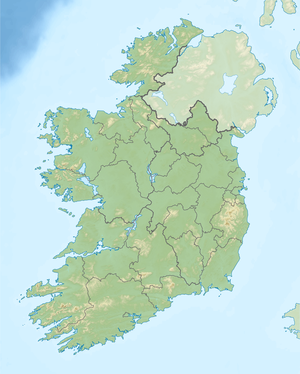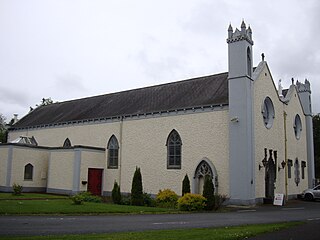
Ballyhaunis is a town in County Mayo, Ireland. It is at the crossroads of the N60 and N83 National secondary roads and on the railway line linking Dublin to Westport and Ballina. Ballyhaunis is within both the Roman Catholic and civil parishes of Annagh.
The Carrowkennedy ambush was an ambush carried out by the Irish Republican Army (IRA) on 2 June 1921, during the Irish War of Independence. An IRA flying column, commanded by Michael Kilroy, ambushed a mobile patrol of the Royal Irish Constabulary including Black and Tans recruits at Carrowkennedy, near Westport, County Mayo. It resulted in the deaths of seven of the RIC, including some who were killed by their own rifle grenade. After two hours the RIC surrendered and their weaponry and ammunition were seized by the IRA.
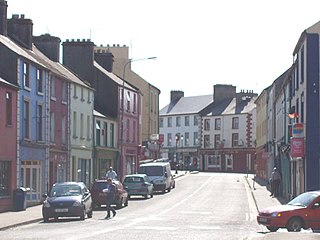
Swinford is a town in County Mayo, Ireland. It is surrounded by a number of smaller villages, including Midfield and Meelick. It is just off the N5 road, 18 km (11 mi) from Ireland West Airport. Situated on a tributary of the River Moy, Swinford is known for its fishing waters, including the Callow lakes and the lakes of Conn and Cullin. Swinford was bypassed in 1993 by the N5 route and was the first town in Mayo to be bypassed.
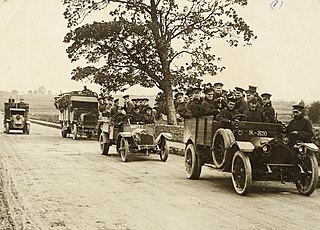
This is a timeline of the Irish War of Independence of 1919–21. The Irish War of Independence was a guerrilla conflict and most of the fighting was conducted on a small scale by the standards of conventional warfare.
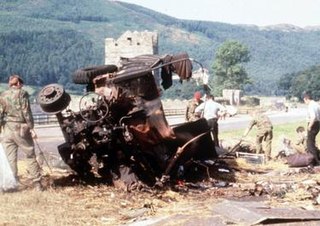
The Warrenpoint ambush, also known as the Narrow Water ambush, the Warrenpoint massacre or the Narrow Water massacre, was a guerrilla attack by the Provisional Irish Republican Army (IRA) on 27 August 1979. The IRA's South Armagh Brigade ambushed a British Army convoy with two large roadside bombs at Narrow Water Castle outside Warrenpoint, Northern Ireland. The first bomb was aimed at the convoy itself, and the second targeted the incoming reinforcements and the incident command point (ICP) set up to deal with the incident. IRA volunteers hidden in nearby woodland also allegedly fired on the troops, who returned fire. The castle is on the banks of the Newry River, which marks the border between Northern Ireland and the Republic of Ireland.

Mourne Abbey, or Mourneabbey, is a small civil and Roman Catholic parish in the barony of Barretts, northwest County Cork, Ireland. The parish is situated just south of Mallow, on the main Mallow-Cork Road and Rail Line. The population of the parish is about 1,000 people. There are two churches and schools in the area, Analeentha and Burnfort. The civil parish consists of 17 townlands.
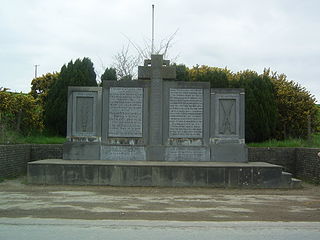
The Crossbarry ambush, also known as the Battle of Crossbarry, occurred on 19 March 1921 and was one of the largest engagements of the Irish War of Independence. It took place near the small village of Crossbarry in County Cork, about 20 km south-west of Cork city. About a hundred Irish Republican Army (IRA) volunteers, commanded by Tom Barry, escaped an attempt by about 1,200 British troops to encircle them. During the hour-long battle, ten British troops and three IRA volunteers were killed.

The Kilmichael ambush was an attack carried out on 28 November 1920 by the Irish Republican Army (IRA) near the village of Kilmichael, County Cork, during the Irish War of Independence. Thirty-six local IRA volunteers commanded by Tom Barry killed sixteen members of the Royal Irish Constabulary's Auxiliary Division. The Kilmichael ambush was politically as well as militarily significant. It occurred one week after Bloody Sunday and marked an escalation in the IRA's campaign.
This is a timeline of the Irish Civil War, which took place between June 1922 and May 1923. It followed the Irish War of Independence (1919–1921), and accompanied the establishment of the Irish Free State as an entity independent from the United Kingdom of Great Britain and Ireland.
The Coolavokig ambush was carried out by the Irish Republican Army (IRA) on 25 February 1921, during the Irish War of Independence. It took place at Coolavokig, on the road between Macroom and Ballyvourney, County Cork. A 60-man flying column of the IRA's 1st Cork Brigade under Seán O'Hegarty, ambushed a 70-man convoy of the Auxiliary Division under Major Seafield Grant, sparking a four-hour battle. Ten Auxiliaries were killed, including Major Grant, and others wounded. The IRA column left the area when British reinforcements arrived. After the ambush, British forces stopped carrying out raids and patrols in the area.
The Scramoge ambush was an ambush carried out by the Irish Republican Army (IRA) on 23 March 1921, during the Irish War of Independence. The IRA ambushed a lorry carrying British troops and Royal Irish Constabulary (RIC) officers at Scramoge, near Strokestown in County Roscommon. Three British soldiers and an RIC officer were killed, while two RIC 'Black and Tans' were captured and shot dead shortly after.
The Sheemore ambush was an ambush carried out by the Irish Republican Army (IRA) on 4 March 1921, during the Irish War of Independence. It took place at Sheemore near Carrick-on-Shannon, County Leitrim.

Michael Kilroy was an Irish republican and politician. He was an Irish Republican Army (IRA) officer in his native County Mayo during the Irish War of Independence and Irish Civil War. Subsequently, he was a Sinn Féin and later Fianna Fáil Teachta Dála (TD) for Mayo South.
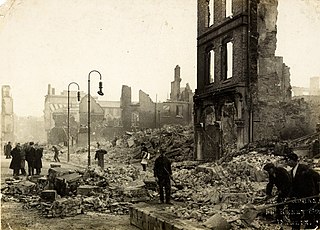
The burning of Cork, by British forces, took place during the Irish War of Independence on the night of 11–12 December 1920. It followed an Irish Republican Army (IRA) ambush of a British Auxiliary patrol in the city, which wounded twelve Auxiliaries, one fatally. In retaliation, the Auxiliaries, Black and Tans and British soldiers burned homes near the ambush site, before looting and burning numerous buildings in the centre of Cork, Ireland's third-biggest city. Many Irish civilians reported being beaten, shot at, and robbed by British forces. Firefighters testified that British forces hindered their attempts to tackle the blazes by intimidation, cutting their hoses and shooting at them. Two unarmed IRA volunteers were also shot dead at their home in the north of the city.
The Tooreen ambush was an ambush carried out by the Irish Republican Army (IRA) on 22 October 1920, during the Irish War of Independence. It took place near Roberts Farm, Tooreen, near Ballinhassig in County Cork. The IRA ambushed two lorries of British soldiers, killing three and wounding four others. The British surrendered and their weapons and ammunition were seized by the IRA. Later that night, British soldiers went on a rampage in nearby Bandon.
The Clonmult ambush took place on 20 February 1921, during the Irish War of Independence.
The Rineen ambush was an ambush carried out by the Mid Clare Brigade of the Irish Republican Army (IRA) on 22 September 1920, during the Irish War of Independence. The attack took place at Drummin Hill in the townland of Drummin, near the hamlet of Rineen, County Clare.
The Kilmeena ambush was an action during the Irish War of Independence that took place at Kilmeena, County Mayo on 19 May 1921. The ambush ended in defeat for the local West Mayo Irish Republican Army (IRA), with five IRA volunteers killed and four wounded and captured. Two members of the Royal Irish Constabulary (RIC) and one Black and Tan were also killed in the action.

On 25 May 1921, during the Irish War of Independence, the Custom House in Dublin was occupied and then burnt in an operation by the Irish Republican Army (IRA). The Custom House was the headquarters of the Local Government Board for Ireland, an agency of the British administration in Ireland, against which the IRA was fighting in the name of the self-proclaimed Irish Republic. The operation, involving over 100 IRA volunteers, was a propaganda coup for the republicans but a military disaster for the IRA in the Irish capital. A force of British Auxiliaries quickly arrived and a gun battle erupted. Five IRA volunteers were killed, along with three civilians, and about 80 volunteers were captured.
The Drumcondra ambush was an attempted ambush carried out the Irish Republican Army (IRA) in Drumcondra, a suburb in northern Dublin, during the Irish War of Independence. On 21 January 1921, an IRA active service unit (ASU) initially set up an ambush near the Royal Canal in preparation for a British lorry which was travelling through the area. When the lorry failed to arrive, Frank Flood, the unit's commander, relocated his men up to a new position along the Tolka river. However, the IRA unit was spotted as they were setting up their new positions and a force of Auxiliaries was sent out, which resulted in 1 volunteer being killed and 5 others being arrested as they were attempting to escape.
